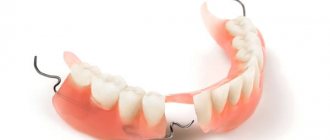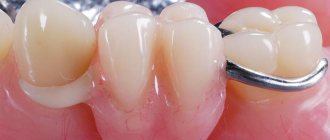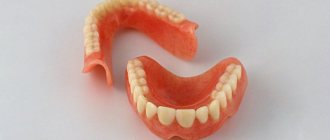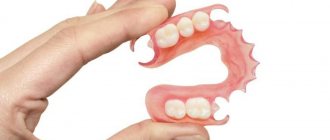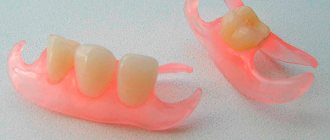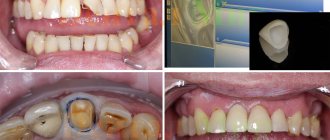Missing teeth today is no longer a problem. This is a common question that can be easily resolved, even when you don’t always have money in your pocket. Because everyone can save a certain amount for a decent prosthesis (and the cost of an immediate prosthesis allows this). I would like to see attractive crowns appear instead of not very attractive holes where teeth have long fallen out. Removable or partially removable bases, permanent or only temporary dentures, for the entire jaw or just a few teeth - an excellent help for anyone who wants to look stunning at any age and under any circumstances. You need to, if not love yourself, then at least respect yourself. And temporary immediate dentures can help with this.
Purpose of butterfly prostheses
A “butterfly” is made, as this type of removable teeth is colloquially called, to help the patient feel comfortable during treatment and while waiting for the arrival of a full-fledged denture. It is much better to walk with teeth than without them. In addition, such a design always helps prevent jaw deformation, as well as restore chewing function after surgery to remove diseased teeth. Tissue renewal and regeneration after such procedures always takes time. But not everyone dares to walk without teeth. In addition, the price of immediate dentures is not so high that you can neglect your health or appearance.
The biggest advantage of such a system is its soft and unusually adaptive base. It is made partly from ordinary plastic. And partly - from such innovative materials as acrylic and its more modern analogue - nylon. The fastenings are so convenient that putting on and removing the “butterfly” will not be difficult. General indications for the manufacture of an immediate prosthesis are as follows:
- removal of one or more teeth - in order to give the tissue time to completely renew itself;
- restoration of normal performance by the jaw of its main function - chewing;
- giving an aesthetically acceptable appearance at the time of dental treatment or while waiting for full prosthetics.
What you should definitely remember is the fragility of the prosthesis. Therefore, they do not wear it for more than three months. If treatment is prolonged, a new system is manufactured.
Dental prosthetics at the President clinic
Do you want to get a prosthesis, but are you afraid of pain? At the President clinic, prosthetics are done quickly and completely painlessly!
More than a million people have become our patients, and here's why:
- modern techniques and materials;
- specialists of the highest category;
- innovative equipment;
- personalized approach;
- physical and psychological comfort during procedures;
- several anesthesia options;
- convenient location - branches in all districts of Moscow.
Don’t put off your health for later, call right now to make an appointment and restore lost teeth in just a few days!
Our team of doctors
Maxillofacial surgeon, Implantologist
Bocharov Maxim Viktorovich
Experience: 11 years
Orthopedist, Neuromuscular dentist
Stepanov Andrey Vasilievich
Experience: 22 years
Orthopedic dentist
Tsoi Sergey Konstantinovich
Experience: 19 years
Endodontist, Therapist
Skalet Yana Alexandrovna
Experience: 22 years
Endodontist, Therapist, Orthopedist
Varvyanskaya Anastasia Andreevna
Experience: 6 years
Dentist-orthodontist
Enikeeva Anna Stanislavovna
Experience: 3 years
When a prosthesis cannot be installed: contraindications for prosthetics
- the crowns of neighboring teeth are destroyed or missing - there is nothing to secure the structure to,
- installation can lead to complications and aggravate the existing disease, for example, if there are inflammatory processes in the oral cavity,
- the units on which the prosthesis is planned to be attached are movable - in this case, the structure will literally “dangle” with them. Here it is better to carry out splinting or completely remove mobile teeth, replacing them with implants,
- The bone tissue at the attachment site is very thin and there is very little of it - again, the prosthesis will not fit properly.
Immediate prostheses and their types
Since oral health problems can vary, as can the number of teeth lost or removed, all butterfly dentures are divided into two groups:
- systems necessary for placing an entire single crown or several scattered ones into empty spaces of the upper or lower jaw;
- designs for complete restoration of the entire dental line.
Each of the named immediate dentures in the photo looks as if a person, smiling, sparkles with his own even and snow-white teeth. Or yellowish, as you may have to. The color of the crowns is easy to select.
Microprosthesis “butterfly” – what is it?
An immediate prosthesis is a removable orthopedic structure, which by its name indicates the English word immediate, which means “immediately”. In a non-professional environment, it got its name due to the design features: the upper part repeats the appearance of a tooth crown, and the lower part is equipped with special fasteners on the sides, which makes it look like a butterfly spreading its wings. Sometimes patients even call him “birdie.”
This is what an immediate prosthesis looks like
The prosthesis has a soft and flexible base, which is invisible against the background of the gums and is individually selected by color. Using neat clasp hooks, it is secured to adjacent teeth. If you need even more reliable fixation, then special gels for dentures can help.
Read more about the material used and the principles of caring for prostheses
Both acrylic and nylon, from which artificial jaws are made, have the following strengths:
- the base of this material literally merges with the gum, becoming almost invisible (in the case of nylon, not visible at all);
- the degree of elasticity is very high, which makes the dentures quite comfortable;
- “Velcro” allows you to simply “glue” the new jaw to the gum, and clasps are easily attached to adjacent teeth.
Of course, for those less strapped for money, it is best to install a nylon butterfly prosthesis, since it is made from the most innovative material using advanced technologies. However, acrylic and plastic systems are no less good.
As for caring for such a structure, it is simple. The jaw is removed from the mouth. Then it is washed with water and cleaned with the most ordinary toothpaste. The only thing you should not forget about is having a fixing gel on hand. Because in addition to the incredible fragility of the “butterfly”, such a system can also easily become loose and fall out from time to time. But a fixation specially designed to correct such troubles solves all problems. And there are enough “butterflies” for three months.
Author:
Features of the technique and procedure of prosthetics
Butterfly dentures are most often installed immediately after the removal of a diseased or decayed tooth, but installation is also possible some time after extraction.
The structures perform several important tasks at once:
- chewing function support;
- masking a missing tooth;
- protection of soft tissues from bacteria and infection;
- prevention of inflammation, periodontal disease and other pathologies;
- temporary dentures prevent the displacement of adjacent teeth and their deformation.
This is an excellent option while making a permanent prosthesis, such as a bridge. They guarantee the patient comfort and the absence of cosmetic defects, are practically invisible in the mouth, and the materials in immediate dentures successfully imitate natural crowns and gums.
And most importantly, the structures have no contraindications and can be installed for any characteristics of the oral cavity and for any physical condition of the patient.
Prosthetics takes place in several simple steps:
- examination and consultation;
- treatment of diseased supporting teeth;
- hygienic cleaning, removal of tartar and deposits, sanitation of the oral cavity;
- taking an impression and making a prosthesis;
- fitting, correction and final installation.
Thus, you receive a ready-made prosthesis in just two visits to the clinic. And this is with the complete absence of pain, surgical intervention and a more than affordable price.
Manufacturing and installation of immediate dentures in our clinic takes only a couple of days.
It is important to consider that butterflies are removable dentures. It is recommended to remove them at night and clean them regularly. If not properly cared for, food debris can become clogged underneath them, bacteria can multiply, inflammation can develop, not to mention such phenomena as bad breath.
Everything you need to know about the shortcomings
The device is removable, so if you want to use it not as a temporary device, but as a permanent one (more than 1 year), the patient may encounter a number of problems. These include stretching and deformation of the material, grinding down of the plastic crown and disruption of occlusion, the risk of the structure falling out of the mouth, and the need to use special glue for better fixation (for example, Coregi). The prosthesis rests on supporting elements, and therefore they are subjected to double load and can quickly collapse.
If you have received a device, and you want its original appearance and convenience to be preserved for as long as possible, then you need to stop eating solid food and all those products that can lead to coloration of the material (strong coffee and tea, red wine, sauces, berries , pomegranate, beets). Remember that the device does not allow you to fully chew food. When you try to eat something hard, it quickly becomes deformed, and also begins to injure and rub your gums.
Purpose of the temporary apparatus
A false tooth “butterfly” solves a number of problems at once:
- restores the aesthetics of the smile and allows the patient to lead an active social life while the tissue heals and a permanent structure is made,
- quickly created - in 1-2 days. If the decision to make a prosthesis was made at the stage of preparation for removal, and the dentistry has its own laboratory, as well as modern equipment, then in general you can leave the clinic without a “gap” in your smile on the day of removal,
- stabilizes the position of the teeth that are located on the sides of the lost one: the likelihood of their loosening, displacement and curvature is eliminated,
- protects mucous membranes, soft tissues and wounds after removal from injury and infection.
Positive aspects of prosthetics
A design such as a temporary prosthesis for the front teeth “butterfly” is easy and quick to install. Moreover, before fixing it, there is no need to prepare, grind, dissect and depulpate (remove the nerve) the supporting elements, as is required when installing bridges. For children, people with sensitive mucous membranes and a tendency to allergies, it is possible to make products without the use of metal elements.
Such a device helps to gain time, which is required for the manufacture of more expensive and permanent structures, for tissue healing after surgical operations. Throughout this period, a person does not have to hide his smile from others.
The prosthesis is removable, so the patient can independently remove it from the mouth as needed (for example, for hygiene purposes).
If the prosthesis is installed on a tooth implant while the artificial root is implanted in the jawbone, it helps the patient adapt and quickly get used to the new state of affairs. After this, getting used to permanent structures will be much easier.
Photos before and after installation
The device looks quite massive, especially when it is used to repair not one, but several consecutive defects. However, its base and hooks, as a rule, are made of materials that almost completely blend in with the color of the natural mucosa. An artificial plastic crown matches the shade of the patient's teeth. You can see what a butterfly prosthesis looks like in the mouth in the photo.
“When the doctor suggested this option after removal, at first I refused: I thought that it would look terrible, and everyone around me would immediately notice it. But in the end, I was won over by the price and the need to somehow hide the problem at least for a while, so I agreed. Surprisingly, everything looks quite natural; none of my friends even asked awkward questions or noticed that it was artificial. Although, maybe everyone around me is just so well-mannered and tactful?!”
NV, review from the dental portal gidpozubam.ru
Alternative options without grinding teeth
Adhesive bridges can be chosen as a temporary solution to conceal defects in the smile area. Their retainers are also very similar to butterfly wings, but they are attached to the supporting units using dental cement. The structures are considered non-removable.
Another option is sandwich dentures. True, these are installed mainly when many teeth are missing in the mouth, but at least a few supporting elements have been preserved. They are literally put on the supporting crowns like a telescope, due to which they are held in place.
If you expect to wear a prosthesis not for 1-2 years, but for at least 4-5 years, then you can consider clasp structures, but only on the condition that you are not allergic to metal. This option is also relevant for patients for whom the “butterfly” is contraindicated due to periodontitis and periodontal disease.
Price
The cost of temporary removable structures directly depends on several factors, in particular, the material used (nylon or acrylic), quantity, city and status of the dentistry that will fix it. The price of products made from nylon is higher than from acrylic.
The average cost of acrylic structures varies from 4,000 to 6,000 rubles (per tooth). The average cost of nylon structures varies from 9,000 to 11,000 rubles (per tooth). In addition to the prosthesis itself, the final price includes the work of the dentist.
Additional services (professional cleaning, removal of carious lesions) are paid separately.
Hygienic care rules
Many patients agree to this method of prosthetics because the “butterfly” is easy to remove for cleaning and just as easy to return to its place. Due to the ideal repetition of the anatomy of the jaw and gums, as well as the effect of vacuum suction (adhesion), the prosthesis is firmly fixed in the mouth.
In order for it to serve for the required time, you need to follow simple rules and care for it:
- rinsing with water after eating,
- cleaning in the usual way, for this you need to remove the structure - here it is better to use soft brushes and toothpaste without abrasives (even children’s will do),
- using an oral product.
Attention! Many patients are concerned about the question of how to properly remove the butterfly prosthesis. The dentist will teach you this during the procedure. First, the plastic hooks are carefully removed, and then, by slowly loosening, the prosthesis itself is removed.
It is important to properly care for the product
The only thing that can cause difficulties is the requirement to exclude coloring drinks and very hard foods (nuts, seeds) from the diet, so as not to displace or damage the structure and reduce the chewing load on it.
“By the age of 28, I was faced with the need to install a butterfly prosthesis. When I removed the bottom four, my dentist warned me that it was worth putting it in so that the teeth would not move in the future. At first I was skeptical, but now I’m convinced that it’s important. It only seems that the hole is not visible. As you can see! But the “butterfly” itself is not noticeable. I can eat a full meal (not nuts, of course). For me it turned out to be very comfortable, it doesn’t press or rub anywhere, it fits tightly. It was uncomfortable at first, but you need to get used to it. Now I only take it out when I brush my teeth. And this is a great option while I’m saving up for an implant.”
Svetlana, Novosibirsk, from correspondence on the woman.ru forum
Wearing rules and service life. Care
There is nothing complicated in the process of wearing and caring for the product. Since the main components from which they are made are absolutely safe, environmentally friendly and, from a biological point of view, inert, they are not a favorable environment for the proliferation of pathogenic microorganisms and bacteria.
They do not support chemical reactions with food substances and saliva. The main thing that should be done regularly is that after each meal, the structure must be removed and rinsed well with warm water, and once a day treated with a special composition for dentures.
If in the first days there are unpleasant sensations in the form of a slight impairment of diction, you should speak more, and after a day or two, the function will be restored.
You should also acquire some skills on how to take off and put on a bow tie. You should spend some time doing this in front of a mirror, then it will become automatic.
As for meals, you should adhere to some restrictions - exclude solid foods, and try to ensure that the portions entering the oral cavity are not too large.
Alternatives
Unfortunately, there are not so many designs that could be used to replace the butterfly prosthesis on an alternative basis. And even those types of products will not be able to compete in price with immediate prostheses, since the high cost of other models, as a temporary option, is unlikely to find many supporters. The most optimal substitutes:
- clasp dentures – metal frame with plastic filling. Suitable in case of major organ loss, when implantation is contraindicated;
- nylon - they are similar to the butterfly model only by the base material, which also atrophies bone tissue with constant use.
Adjustment period
If the device is quite massive, for example, it is designed to replace 3 teeth at once, then at first it may cause discomfort and feel like a foreign body in the mouth. For some patients, implants placed on the front teeth may interfere with the pronunciation of certain sounds and provoke increased secretion of saliva. Discomfort is felt in the area of contact between the structure and the gum, as well as in the area of the “supports”, since they now bear an increased load.
At first, there may also be pain1 in the area of the remote units, since the intermediate part of the device exerts pressure on the alveoli. However, orthopedists claim that if the design is created taking into account your individual anatomical features, then the problems listed above will disappear within 10–14 days after the installation of the “butterfly”.
Price
The cost of a butterfly prosthesis depends on the materials used in manufacturing. The cost of the cheapest design can start from three thousand rubles. In this design, the teeth and base will be made of plastic, which is not particularly durable.
But if you choose an option that uses nylon as a base, and the teeth consist of ceramic crowns, the cost can reach up to thirty thousand rubles.
Indications for installation
The prosthesis has a number of main indications for the use of prostheses - “butterflies”, when such designs are considered the highest priority:
- young people and older schoolchildren, since the installation of stationary, non-removable products at this age is not justified - the bone tissue has not yet been fully formed and is subject to age-related changes. This means that the permanent device may become displaced or deformed as the bone grows;
- as a temporary measure to prevent displacement that may occur during the production of a permanent implant. This will not only strengthen the teeth, but also relieve discomfort and improve the appearance of the oral cavity;
- if the patient refuses to grind adjacent teeth to install other types of structures. However, this is only possible in cases of replacing one tooth;
- the patient is diagnosed with 100% tooth loss;
- before the implantation procedure to restore the thinned area of the jaw. This happens when a patient, having lost one or more organs, refuses prosthetics for a long period of time;
- for dental reasons, when the use of other methods of dental restoration is considered impossible due to the anatomical features of the jaw structure or medical requirements.
Why the design is called a “butterfly”
A “butterfly” dental microprosthesis is an orthopedic structure consisting of one or more artificial crowns, a soft base that imitates the gum, and attachments extending from it that look like the spread wings of a butterfly. Some specialists and patients sometimes call the design a “birdie”.
“The official name accepted among dentists is immediate prosthesis. The word immediate means “immediate” or “used immediately.” That is, such a structure is installed immediately after extraction (removal) in order to protect the formed socket, reduce the likelihood of developing postoperative complications, and prevent displacement of the remaining teeth. This solution is temporary, but if the patient ultimately fails to get a permanent prosthesis or implant, then with precision execution, good care and compliance with all medical recommendations, the design can last up to 3 years,” says orthopedic dentist B.S. Sambuev.

